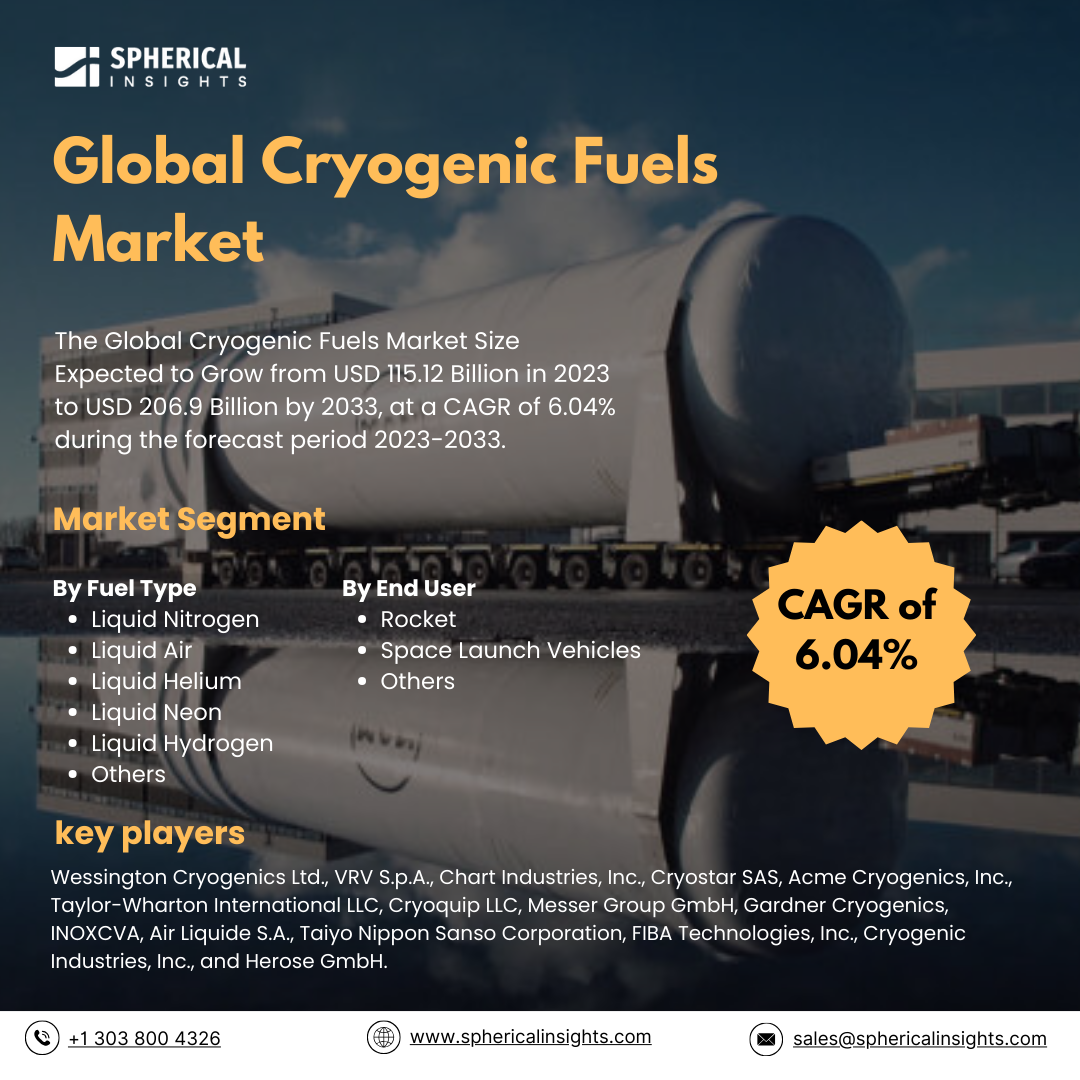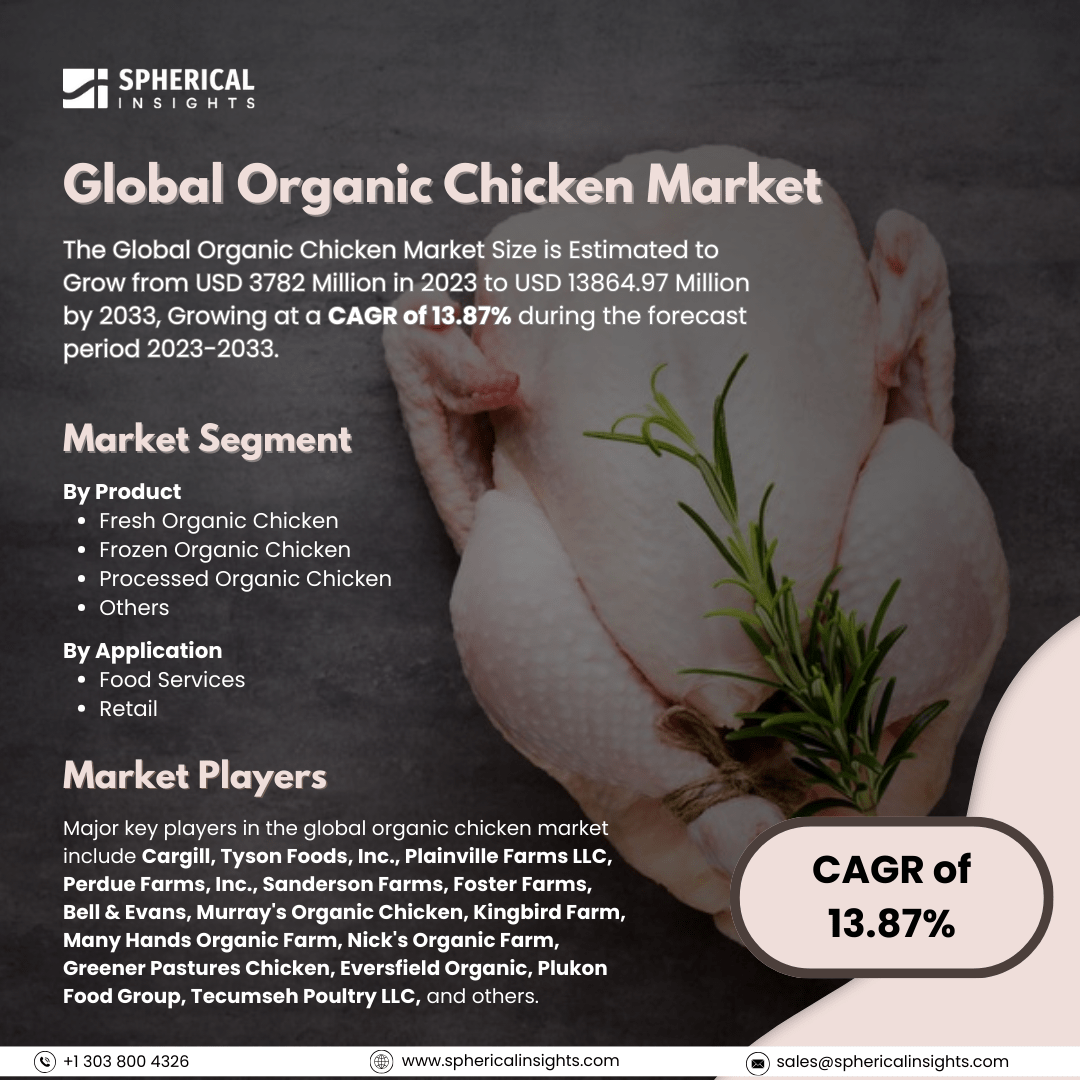Global Cryogenic Fuels Market to Exceed USD 206.9 Billion by 2033
According to a research report published by Spherical Insights & Consulting, the Global Cryogenic Fuels Market Size Expected to Grow from USD 115.12 Billion in 2023 to USD 206.9 Billion by 2033, at a CAGR of 6.04% during the forecast period 2023-2033.
Browse 210 market data Tables and 45 Figures spread through 190 Pages and in-depth TOC on the Global Cryogenic Fuels Market Size, Share, and COVID-19 Impact Analysis, By Fuel Type (Liquid Nitrogen, Liquid Air, Liquid Helium, Liquid Neon, Liquid Hydrogen, and Others), By End User (Rocket, Space Launch Vehicles, and Others), and By Region (North America, Europe, Asia-Pacific, Latin America, Middle East, and Africa), Analysis and Forecast 2023 – 2033
Fuels known as cryogenic fuels are those that have been cooled to below freezing in order to maintain their liquid state. The two most widely used cryogenic fuels are liquid oxygen (LOX) and liquid hydrogen (LH2). Due to their ability to provide powerful thrust with comparatively minimal weight, these fuels are utilized in rocket engines. Heavy-insulated tanks are used to hold cryogenic fuels in order to maintain their low temperature. -253°C is the required storage temperature for liquid hydrogen, and -183°C is the required storage temperature for liquid oxygen. Cryogenic fuels are necessary for space travel because they offer the strong push required to overcome Earth's gravity and enter orbit. Additionally, the future demand for cryogenic fuels is anticipated to be driven by the expanding need for industrial gasses. The global cryogenic fuels market is expanding due to technological developments in cryogenic storage and transportation. However, weight restrictions and the difficulty of maintaining cryogenic temperatures are the main sources of constraint in aeronautical cryogenic fuel systems.
The liquid nitrogen segment is expected to hold a significant market share through the forecast period.
Based on the fuel type, the global cryogenic fuels market is categorized as liquid nitrogen, liquid air, liquid helium, liquid neon, liquid hydrogen, and others. Among these, the liquid nitrogen segment is expected to hold a significant market share through the forecast period. Liquid nitrogen is the market leader worldwide due to its shallow boiling point at atmospheric pressure. Cryogenic fuels are made using vacuum insulation to keep their boiling point low. The aerospace industry's growing need for liquid nitrogen is matched by the need for aircraft cryogenic fuels for nitrogen delivery and storage.
The space launch vehicles segment is expected to grow at the fastest CAGR during the projected timeframe.
The global cryogenic fuels market is segmented by end-users into rockets, space launch vehicles, and others. Among these, the space launch vehicles tracking segment is expected to grow at the fastest CAGR during the projected timeframe. The high energy density and effective combustion characteristics of cryogenic fuels, especially liquid hydrogen (LH2) and liquid oxygen (LOX), make them essential parts of contemporary space launch vehicles.
North America is projected to hold the largest share of the global cryogenic fuels market over the projected timeframe.
North America is projected to hold the largest share of the global cryogenic fuels market over the projected timeframe. The expansion of the cryogenic fuel market in North America is driven by the rising requirement or demand for natural gas as a cleanser counterfeit product to traditional fuels. In the United States, the revolution of shale gas has generated plenty of natural gas, which caused a decrease in the cost of fuel and rendered it a better alternative for both energy production and transportation.
Asia Pacific is projected to grow at the fastest CAGR growth of the global cryogenic fuels market during the forecast period. The Asia Pacific region is home to emerging nations in the world including countries like China, Japan & India, and has an increasing need for industrial gasses and energy. The region's increasing demand for LNG is driven by increasing population count industrialization, and urbanization. The increasing demand for commercial or industrial gas in the Asia Pacific is due to the increasing utilization of gas and the growth of industries like food, healthcare, chemicals, and electronics.
Companies Profiles
Major vendors in the global cryogenic fuels market are Wessington Cryogenics Ltd., VRV S.p.A., Chart Industries, Inc., Cryostar SAS, Acme Cryogenics, Inc., Taylor-Wharton International LLC, Cryoquip LLC, Messer Group GmbH, Gardner Cryogenics, INOXCVA, Air Liquide S.A., Taiyo Nippon Sanso Corporation, FIBA Technologies, Inc., Cryogenic Industries, Inc., and Herose GmbH.
Key Target Audience
- Market Players
- Investors
- End-users
- Government Authorities
- Consulting and Research Firm
- Venture capitalists
- Value-Added Resellers (VARs)
Market Segment
This study forecasts revenue at global, regional, and country levels from 2020 to 2033. Spherical Insights has segmented the global cryogenic fuels market based on the below-mentioned segments:
Global Cryogenic Fuels Market, By Fuel Type
- Liquid Nitrogen
- Liquid Air
- Liquid Helium
- Liquid Neon
- Liquid Hydrogen
- Others
Global Cryogenic Fuels Market, By End User
- Rocket
- Space Launch Vehicles
- Others
Global Cryogenic Fuels Market, By Regional
- North America
- Europe
- Germany
- UK
- France
- Italy
- Spain
- Russia
- Rest of Europe
- Asia Pacific
- China
- Japan
- India
- South Korea
- Australia
- Rest of Asia Pacific
- South America
- Brazil
- Argentina
- Rest of South America
- Middle East & Africa
- UAE
- Saudi Arabia
- Qatar
- South Africa
- Rest of the Middle East & Africa



